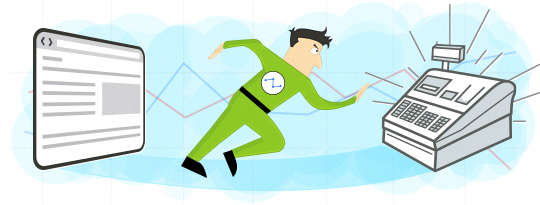Analytics Blog

In-Store (Offline) Tracking with Google’s Universal Analytics
Can you imagine counting the in-store purchase as part of a more complete conversion path from campaign, to landing page, to intermediate conversion steps, to online, AND now, to offline transaction? We now have the ability to help you send offline activities occurring in brick and mortar stores to Google Analytics using Universal Analytics.
One Small Next Step or One Giant Leap in Tracking Offline Conversions?
With Google’s new Universal Analytics at our fingertips, my mind had been spinning with ideas on how to take advantage of it. I want to explore some of its new features, especially taking advantage of offline tracking events and bringing them in to analytics to track completely different types of conversion activities than what I see in today’s analytics.
To start off, I will share the “least complex” hypothetical scenario of tracking offline conversions; a sale made at a brick and mortar store. Let’s explore how to bring this new offline sales data into analytics.
Wally’s Widgets Are Wonderful
Let’s start with the fictitious retail chain that sells widgets made by Wally. I hear they are wonderful! But what Wally wants to know is how to optimize getting people to visit his store. Selling online may make up 20% of his sales, but he knows his widgets sell themselves if people can see them up close.
Online Widget Goals
Wally’s current analytics reports are monitoring goals today capturing eCommerce conversions as people buy online. He is also tracking goals designed as soft conversions where site visitors drill down to a “locations nearest you” page with the expectation that an increase in pageviews here means more in-store visits.
But in this latter goal scenario, this isn’t the ideal measurement. Not when the possibility exists to track the customer coming into the store and making a purchase. In an IDEAL world, it would be wonderful if Wally could track the complete conversion goal path from first web visit to in-store sale. Um, Wally, do we have a problem?
The Cookie Crumbles?
As idyllic as it sounds, as soon as a web visitor turns off their browser and drives to the store, Wally loses the ability to track some critical information. Current analytics session-based cookie data have a limited lifespan, and as much as I want it, the customer walking into the store won’t be providing me with his computer’s cookies on a thumb drive.
So let’s continue to poke at this idea, but with the first refinement to our objective: let’s track a sale made at a brick and mortar store and ignore the web site visit (gasp).
Time to Talk Physics
I am sure there is a retail corollary to Sir Isaac Newton’s laws of motion, but plain and simple, if we want to optimize sales (reactions) we need to know what the driving forces (actions) that brought the customer to our store. This means we need to run some sort of marketing campaign.
So now Wally decides to run a postcard campaign to drive people to his store using some fancy “Bring This Coupon In” wording. The objective being that once a sale is made, we can send the conversion event to Google’s Universal Analytics (UA) in an offline transaction. Here’s where another small but important operational consideration comes into focus. I might be successful at getting people in the door, but ideally I want that piece of paper folded up in their pocket regardless of if they buy or not. I would love to get counts of:
- Total number of postcards sent
- Total dollars spent on postcards
- Off-line Total number of visitors to the store as a result *
- Off-line Total number of sales as a result
- Off-line Total dollars as a result
* If a customer simply comes in and walks out, I miss out on the 3rd item above.
Success?
Hey, my initial objective is in motion and is feasible. Wally can now track metrics never seen before with the added Universal Analytics data.
Note to Wally: Be sure to contact your point of sale vendor to see if they can enhance your system to add a new Google Measurement Protocol web service call. Be sure to send the detail about which store the customer visited so future segmentation analysis can be done.
Note to analytics staff: Currently Google Universal Analytics will not have the number of postcards or the dollars spent, nor will we have the raw number of store visits. What will be needed is to manually construct this data in a spreadsheet then add in the final offline in-store conversions downloaded from Universal Analytics. Oh, be sure that you have set up a separate web property for these offline sales as sending this data to your existing web property used for website visits will impact your web metrics.
One Small Improvement
Wally now believes that he can use electronic media rather than postcards. He now designs a marketing campaign to drive prospects to the website, and maybe ultimately to the store. As mentioned above, store sales are still a big percent of Wally’s business and we want to track within Universal Analytics the NEXT step after the “locations nearest you” goal in the conversion funnel, if possible.
A More Complete Path
So Wally sends a batch of emails out, drives some percentage of prospects to his custom landing page, and yes, invites them into the store using a “Bring This Coupon In” (or bring your virtual coupon on your mobile). We still don’t have the thumb drive. We can’t grab the cookie off his phone. But now we have the ability to send back to Universal Analytics the new activity tied to the coupon that includes the web visitor ID. We have the last step of counting the sale as part of a more complete path from campaign, to landing page, to conversion steps, to online AND offline purchase.
For those ready to starting seeing this 360 degree view in tracking sales, contact us to make this offline tracking concept a reality.
If you want to learn more about the benefits of Universal Analytics, check out our case study on transitioning Yellow Pages from Adobe SiteCatalyst analytics to Google Analytics Premium/Universal Analytics. If you want to get a more technical understanding, check out this post by Daniel Waisberg, or you can really geek out with this great post by Justin Cutroni.








